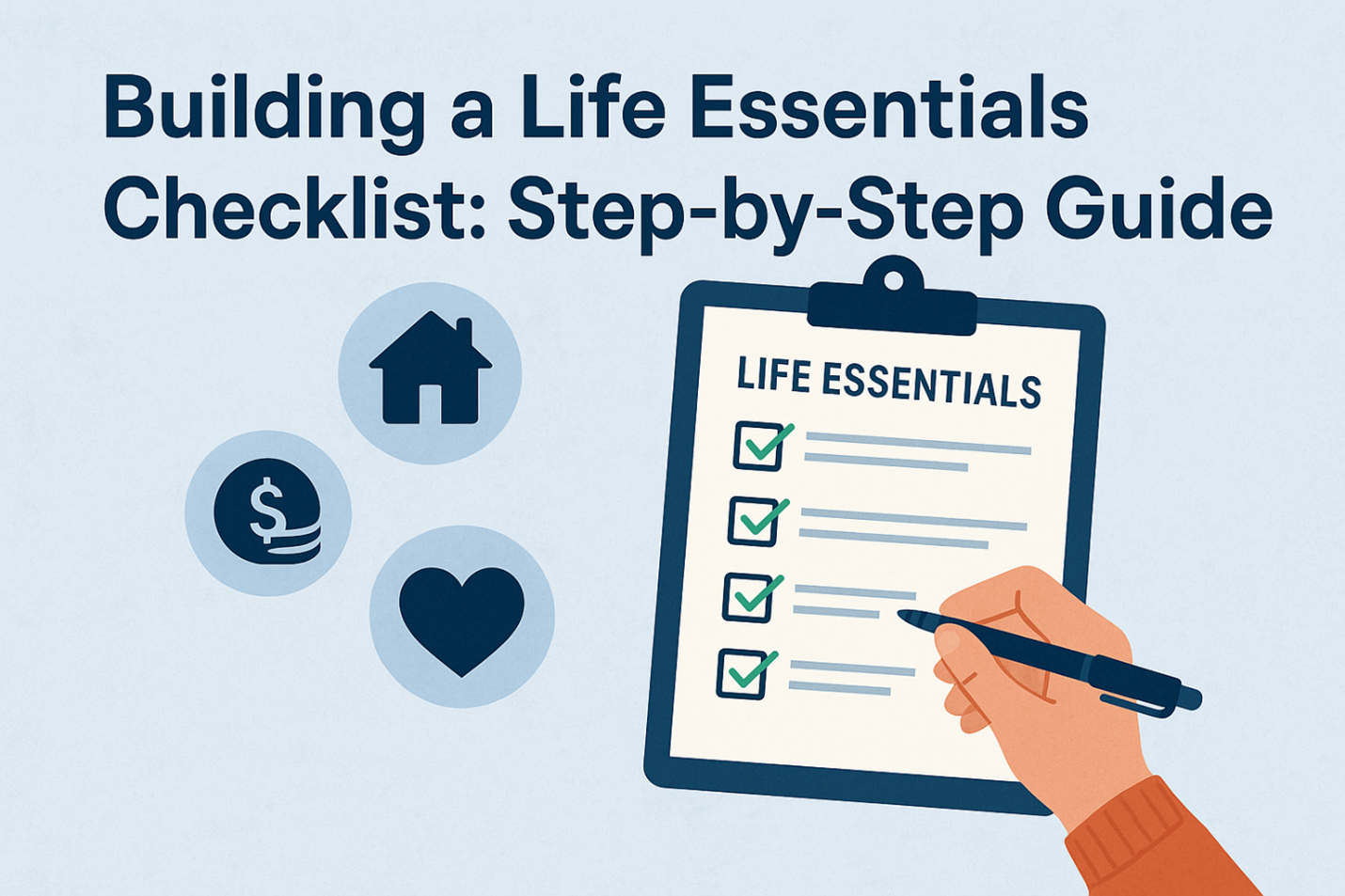Why a Life Essentials Checklist Is Critical
Life Essentials Checklist is more than a simple list of documents, it’s a roadmap for your loved ones and a safeguard for your own peace of mind. In times of crisis, whether due to illness, sudden emergencies, or major life transitions, having vital information organized and accessible can prevent confusion, delays, and unnecessary stress.
Without a checklist, families often scramble to locate insurance policies, medical directives, or account details when they are needed most. By proactively assembling these essentials, you not only ensure that your wishes are respected but also relieve loved ones of the burden of piecing things together under pressure.
A checklist acts as a single source of truth, covering everything from identification documents and financial accounts to healthcare and digital logins. Ultimately, it transforms preparation into empowerment, turning uncertainty into clarity and giving both you and your family confidence in facing the unexpected.
Step 1: Understand the Purpose of Your Checklist
- What a Life Essentials Checklist Covers (beyond estate planning)
- Who Benefits from Having It Ready
A Life Essentials Checklist goes well beyond traditional estate planning. While wills and trusts are important, they represent only a fraction of the information families need in emergencies or major life changes. A comprehensive checklist covers identification documents, medical directives, insurance policies, financial accounts, property records, and even digital logins.
It’s about organizing all the critical details that make daily life function smoothly. Having this ready, benefits more than just you, it’s invaluable for your spouse, children, or caregivers who may need to act on your behalf. By creating a checklist, you reduce uncertainty, save time in urgent situations, and provide clarity and peace of mind for everyone involved.
Step 2: Gather the Core Categories of Information
- Personal Identification & Vital Records
- Financial Accounts & Assets
- Legal & Estate Planning Documents
- Healthcare Directives & Medical Records
- Insurance Policies
- Digital Accounts & Passwords
- Property & Real Estate Information
- Emergency Contacts & Family Information
(Each of these could be H3s under this step, aligning with the pillar + existing clusters.)
The foundation of your Life Essential Checklist Template is gathering information across key categories. Start with personal identification and vital records, birth certificates, passports, and Social Security details.
Next, include financial accounts, assets, and legal or estate planning documents such as wills or powers of attorney. In addition, healthcare directives, medical records, and insurance policies ensure critical coverage is clear.
Don’t overlook digital accounts and passwords, which are increasingly vital. So too are property and real estate records, which help protect ownership. And, of course, emergency contacts and family information will help provide quick access to trusted support.
Collecting these categories creates a complete, reliable resource for you and your loved ones.
Step 3: Choose the Right Format
- Paper vs. Digital (Pros & Cons)
- Hybrid Options That Work for Most Families
Choosing the right format for your Life Essentials Checklist depends on accessibility, security, and personal preference. A paper file offers simplicity and requires no technology, but it’s vulnerable to loss, damage, or unauthorized access.
A digital version provides convenience, easy updates, and secure backup options, though it requires strong passwords and cybersecurity practices.
For most families, a hybrid approach works best: maintain a printed copy of the most critical documents while also storing digital files in encrypted folders or secure cloud storage. This combination ensures both resilience and convenience, giving you reliable access in a variety of circumstances.
Step 4: Organize and Prioritize
- What to Put in First?
- How to Layer Updates (annual, life events, emergencies)
When building your Life Essentials Checklist, organization and prioritization are key. Start with the most time-sensitive and critical items, such as medical directives, emergency contacts, and insurance policies, so they are ready when needed most. Next, add financial accounts, property records, and legal documents that guide longer-term planning.
To keep everything current, layer in regular updates: schedule an annual or bi-annual review to confirm details, and make immediate changes when major life events occur, like marriage, divorce, a new child, or relocation. During emergencies, focus on ensuring quick access to essential documents. This structured approach keeps your checklist accurate, reliable, and effective.
Step 5: Secure and Share Responsibly
- Best Practices for Protecting Sensitive Information
- Deciding Who Gets Access and How
Securing your Life Essentials Checklist is just as important as creating it. These documents contain highly sensitive information, so best practices include using strong passwords, encryption, and secure storage, whether in a locked physical location or trusted digital vault. Avoid leaving copies in easily accessible places.
Just as important is deciding who gets access. Identify one or two trusted individuals, such as a spouse, adult child, or executor, and ensure they know how to retrieve the checklist when needed.
By balancing protection with responsible sharing, you safeguard your privacy while ensuring loved ones can act quickly in critical moments.
Step 6: Maintain and Update the Checklist
- Key Life Events That Trigger Updates
- Scheduling an Annual Review
A Life Essentials Checklist only remains valuable if it’s kept current. Key life events, such as marriage, divorce, the birth of a child, retirement, or purchasing property, should always trigger an immediate update. These milestones often change legal, financial, or healthcare arrangements, making outdated information risky.
In addition to event-driven updates, schedule a bi-annual review to confirm accuracy and completeness. This practice ensures that account numbers, policies, and contact details are up to date. By treating your checklist as a living document, you create a reliable resource that adapts to life’s changes and provides ongoing peace of mind.
Step 7: Download and Customize Your Template
- How to Use the Free Checklist Resource
- Making It Work for Your Family’s Unique Needs
Your Life Essesntial Checklist Template becomes most effective when you tailor it to your unique circumstances. Start by downloading the free template provided, which gives you a structured framework of core categories.
Use it as a guide, filling in details such as account numbers, policy information, and emergency contacts. Then customize, add sections for business interests, pet care instructions, or cultural preferences in healthcare if they apply.
The goal is to make the checklist reflect your life, not just a generic model. By personalizing the template, you create a resource that truly supports your family’s needs at all times.
Conclusion
- Peace of Mind Through Preparation
- Download the Life Essentials Checklist
Creating a Life Essentials Checklist is one of the most helpful steps you can take to protect yourself and your loved ones. By organizing critical documents and information, you transform uncertainty into clarity and ensure that important decisions can be made without stress or confusion.
The true value lies in the peace of mind that comes from knowing you are prepared for both everyday needs and unexpected events.
Don’t wait until a crisis forces the issue, take control now. Download the free Life Essentials Checklist today and start building a resource that safeguards what matters most.


